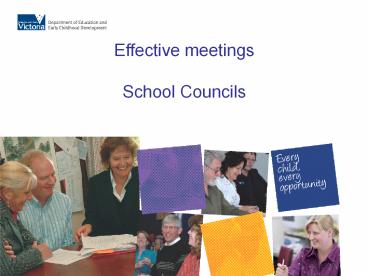Effective meetings: School Councils - PowerPoint PPT Presentation
Title:
Effective meetings: School Councils
Description:
School Councils Conducting the actual meeting for the chair or convenor Open the meeting Start by welcoming everyone to the meeting. Check that everyone has ... – PowerPoint PPT presentation
Number of Views:131
Avg rating:3.0/5.0
Title: Effective meetings: School Councils
1
Effective meetingsSchool Councils
2
Planning for effective meetings
- Planning
- What do you want from the meeting?
- What do you need to achieve?
- Notifying people
- Who is invited?
- Set a date and time
- Preparation
- Make an agenda
- Decide what needs to be decided, what needs to be
discussed, what needs to be advised - Allow time for each agenda item
3
Effective meetings (continued)
- Meeting processes
- Controlling the meeting
- Understanding roles
- Keeping a record
- Keeping notes from the meeting
- What to do with action items (decisions)
4
Roles
- Chairperson/convenor
- Prepares and runs the meeting
- Ensures the meeting stays on track and on time
- Secretary/recorder
- Keeps notes (minutes) during the meeting and
writes them up after the meeting - Meeting participants
- Have a say, stay involved, listen to each other
5
Quorum
- A quorum is the number of people required to be
present at a meeting before a valid decision can
be made - A quorum is achieved at a school council meeting
if not less than one half of the members of the
school council currently holding office are
present and a majority of the members present are
not DEECD employees - A parent member who is also a DEECD employee is
counted as a DEECD representative for quorum
purposes - In the event of a tied vote, the presiding member
has a second or a casting vote.
6
Members responsibilities
- Be on time or send an apology if you are unable
to attend - Listen without interrupting
- Listen to understand
- Think before you speak
- Dont speak for the sake of it
- Be fair in your criticism
- Make sure you understand whats been decided
7
More on the people side
- Set and agree on the rules of how the meeting is
to work - What behaviour is allowed, what is not allowed
- Open or closed meeting
- Be clear on roles - especially the chairpersons
role - Manage time
8
The meeting itself
- Open the meeting
- Welcome everyone
- Ensure people have received their papers
- Conduct the discussion
- See next slide
- Summarise the meeting
- Point out main discussions and any decisions made
- Close the meeting
- Thank people for coming
9
Structure of a discussion
- State the issue or topic of discussion
- Hear the facts
- Listen to peoples arguments, experiences,
opinions - Reach a conclusion on whats wanted
- Make a decision
- Record the decision
10
Minutes of the meeting
- The minutes of the meeting must record
- date, time, place of meeting, attendees and
chairperson and apologies received - agenda items discussed
- all decisions including the names of the movers,
seconders and if decision carried or rejected - time the meeting ended
- date, time and place of next meeting
11
Meeting checklist
- People notified - time, date, venue
- Agenda set and sent in advance
- Discussion papers sent in advance with a
recommendation on what is required from the
meeting e.g. - For information
- For a decision- that is, a recommendation
- Check any actions required following last meeting
12
For more information
- http//www.education.vic.gov.au/management/governa
nce/schoolcouncils/role.htm - (What is a school council and what does it do?)
- http//www.ourcommunity.com.au for Help Sheets on
running a meeting































